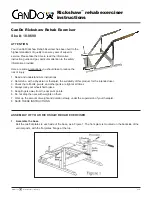
USER GUIDE 4.0
MANOEUVRING THE WHEELCHAIR
4.1. PUSHING THE WHEELCHAIR
Apply
•
both wheel brakes (refer to page 3 for brake type) & make sure client is
comfortable/securely seated in the wheelchair (see user guide 3.0).
Set
•
tilt (if fitted) to suit the clients needs & adjust
handle height.
Release
•
both wheel brakes (refer to page 3 for
brake type) Note: always apply both wheel
brakes when stationary for long periods of
time.
Push
•
the wheelchair by using both hands on the
handles provided to prevent instability and erratic
steering.
To
•
tilt the wheelchair back (for going up kerbs,
etc.), lower the foot pedal at the rear of the
wheelchair (Fig.4.1a) and press down with the
foot (Fig.4.1b).
Never
•
let go of the wheelchair unless both
wheel brakes are applied.
Always
•
look well ahead to avoid any hazards
and to prevent any sudden directional
changes.
Never
•
push the wheelchair above walking
pace or turn suddenly to prevent distressing
the client or causing harm to passers by.
Never
•
allow anything to hang near or on the
wheels (i.e. Clothing, clients equipment, etc.).
Never
•
hang anything on the back of the
wheelchair (i.e. Bags, coats, etc.) as this
could cause instability during use.
The
•
wheelchair should only be used by the
client it was supplied for and NO other person.
Always
•
use both hands and foot lever (Fig.4.1b) when tilting the wheelchair.
Never
•
tilt the wheelchair too far back as to make it unstable.
Never
•
approach the kerb at an angle, always approach straight to prevent one
side lowering before the other causing sideways instability.
If
•
possible always place the wheelchair in the reverse position to drop down a
kerb.
23
Fig.4.1b
Fig.4.1a





































